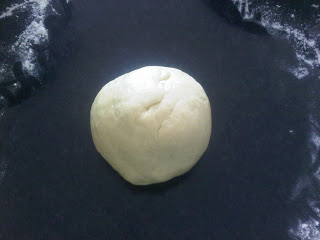Coffee Cake.
Disclaimer: I was never very good at planning, nor food photography. Please excuse the crappy photos and obvious lack of "process" shots. I'm learning.
I can't tell you how relieved I am that this challenge turned out! This was my first challenge, and came directly on the heels of a long vacation. Even though my last post saw me touting some DB Challenges as "doable", I have the tendency to get ahead of myself and not always think things through. Especially with baking. Especially with cakes. For supplementary material, friends can see my facebook statuses ca. my birthday (Feb 19) this year. In summary, quite a few attempted cakes resulted in failure, anger, and wasted ingredients.
 |
| Fresh out of the oven. |
 |
| Just look at that spiral! First piece, cross-section checks out. Phew! |
 |
| The star of the show: Sweet yeasted dough, before first rise. |
I only have two tips to point out in this recipe, and both regard the yeast component.
First, although the recipe says to combine flour, sugar, salt, and yeast before mixing your wet dough ingredients, I would slow down here. Salt inhibits yeast activity, so I added the salt at the last minute, which is common for many bread recipes. I made my liquid mixture first, and then mixed the dry the ingredients together before combining the two mixtures.
Second, optimal yeast activity occurs with lukewarm water - not too hot, and not too cold. Too hot, and the yeast will die, and too cold, they won't go to work. I have a feeling that my liquid mixture was too hot when I added it to the dry ingredients. Be careful to only heat the liquids until the butter is just melted, and if it is too hot (ie. not lukewarm/warm), let it cool down a bit. I'm fairly certain that this could account for the lack of doubling in my dough.
One of the difficulties of working with yeast, if you're someone with anxiety problems such as Yours Truly, is that it is very easy to drive yourself crazy during the rising of your dough. A good rule of thumb for most rises, and what many recipes will indicate, is to cover your dough ball, and let it rise until it's "roughly doubled in size". Well, you can imagine how many times in the 45-60 minute period I popped the tea towel to check on the little guy. My dough definitely did not rise properly - after about 1.25 hours it was maybe 1.5x the size. This could be either due to the fact that my liquid was too hot (see above), or that, because I halved the recipe, there may not have been enough yeast and food for a true doubling to occur. Similarly, the second rise was pretty much useless, as I didn't notice a change in size whatsoever.
The rise is something that I really love about yeast baking, and has kind of inspired me to pursue more of it (next project; babka!). There is something really gratifying about kneading dough, and being able to feel the changes in elasticity, suppleness, and tackiness as your gluten network develops and the dough comes to life. And then, as if that wasn't enough, checking your dough after the first rise to find that it has grown massively is one of life's great ego-boosters. I think everyone should try it at least once.

Here's the recipe. Enjoy!
Your post is full of wise advice and the cake itself is stunning I love the colour of the crust and the internal swirl of "chocolate meringue" is perfect yes you are right this cake is very reminiscent of a number of good quality "bakery" cakes, and that is good point about it being "low calorie" as compared to normal coffee cake. Well done great work.
ReplyDeleteCheers from Audax in Sydney Australia.
It looks great and seems to have risen perfectly! The swirl is really great!
ReplyDelete